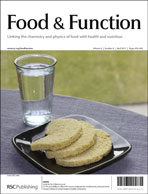Epidemiological and animal studies point to a possible protective effect of citrus flavonoids against cardiovascular diseases. The aim of this study is to investigate the effects of citrus flavonoids, 5-hydroxy-3,6,7,8,3′,4′-hexamethoxyflavone (5-OH-HxMF) and 3,5,6,7,8,3′,4′-heptamethoxyflavone (HpMF), on the activities and expressions of macrophage scavenger receptors and the hepatic LDL receptor. Treatment of HpMF (20 μM) during THP-1 differentiation successfully attenuated 12-myristate 13-acetate (PMA)-mediated DiI-labeled oxidized low-density lipoprotein (oxLDL) uptake as evidenced by flow cytometry, indicating that the functions of scavenger receptors were blocked. RT-Q-PCR analysis suggests that the decrease in oxLDL uptake was due to the down-regulation of PMA-induced SR-A mRNA expression. In terminally differentiated THP-1 macrophages, 5-OH-HxMF and HpMF could significantly reduce DiI-oxLDL uptake, with the former having a greater effect. 5-OH-HxMF attenuated oxLDL-mediated CD36 and SR-A expression; while HpMF only decreased CD36 expression. The effects of these two flavonoids on the activity and expression of the hepatic LDL receptor (LDLR) were further investigated in HepG2 cells. 5-OH-HxMF (10–20 μM) enhanced DiI-LDL uptake by 1.33-fold due to the enhanced LDLR expression. These results imply that HpMF is better at inhibiting PMA-induced oxLDL uptake during THP-1 differentiation, while 5-OH-HxMF is more powerful in attenuating oxLDL-induced scavenger receptor expression and activity in terminally differentiated THP-1 macrophages. Furthermore, 5-OH-HxMF may have hypolipidemic activity due to its up-regulating hepatic LDLR expression.


 Please wait while we load your content...
Please wait while we load your content...